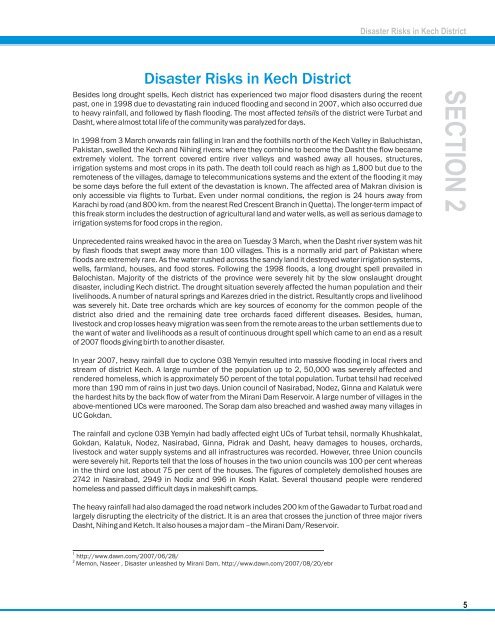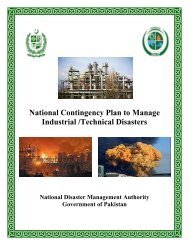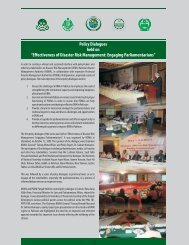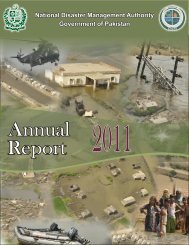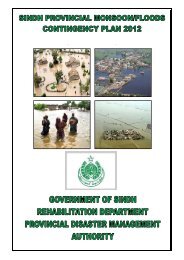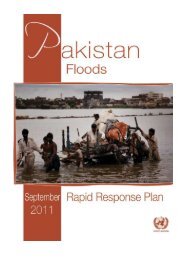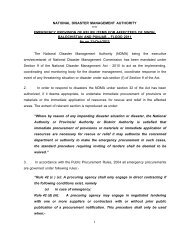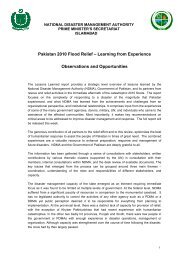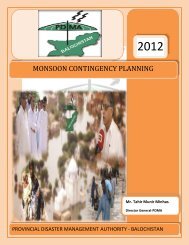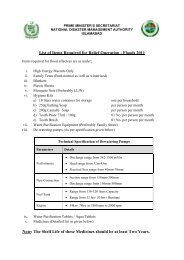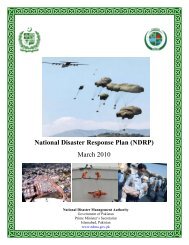District Disaster Management Plan District Kech, Balochistan - NDMA
District Disaster Management Plan District Kech, Balochistan - NDMA
District Disaster Management Plan District Kech, Balochistan - NDMA
Create successful ePaper yourself
Turn your PDF publications into a flip-book with our unique Google optimized e-Paper software.
<strong>Disaster</strong> Risks in <strong>Kech</strong> <strong>District</strong><br />
<strong>Disaster</strong> Risks in <strong>Kech</strong> <strong>District</strong><br />
Besides long drought spells, <strong>Kech</strong> district has experienced two major flood disasters during the recent<br />
past, one in 1998 due to devastating rain induced flooding and second in 2007, which also occurred due<br />
to heavy rainfall, and followed by flash flooding. The most affected tehsils of the district were Turbat and<br />
Dasht, where almost total life of the community was paralyzed for days.<br />
In 1998 from 3 March onwards rain falling in Iran and the foothills north of the <strong>Kech</strong> Valley in Baluchistan,<br />
Pakistan, swelled the <strong>Kech</strong> and Nihing rivers: where they combine to become the Dasht the flow became<br />
extremely violent. The torrent covered entire river valleys and washed away all houses, structures,<br />
irrigation systems and most crops in its path. The death toll could reach as high as 1,800 but due to the<br />
remoteness of the villages, damage to telecommunications systems and the extent of the flooding it may<br />
be some days before the full extent of the devastation is known. The affected area of Makran division is<br />
only accessible via flights to Turbat. Even under normal conditions, the region is 24 hours away from<br />
Karachi by road (and 800 km. from the nearest Red Crescent Branch in Quetta). The longer-term impact of<br />
this freak storm includes the destruction of agricultural land and water wells, as well as serious damage to<br />
irrigation systems for food crops in the region.<br />
SECTION 2<br />
Unprecedented rains wreaked havoc in the area on Tuesday 3 March, when the Dasht river system was hit<br />
by flash floods that swept away more than 100 villages. This is a normally arid part of Pakistan where<br />
floods are extremely rare. As the water rushed across the sandy land it destroyed water irrigation systems,<br />
wells, farmland, houses, and food stores. Following the 1998 floods, a long drought spell prevailed in<br />
<strong>Balochistan</strong>. Majority of the districts of the province were severely hit by the slow onslaught drought<br />
disaster, including <strong>Kech</strong> district. The drought situation severely affected the human population and their<br />
livelihoods. A number of natural springs and Karezes dried in the district. Resultantly crops and livelihood<br />
was severely hit. Date tree orchards which are key sources of economy for the common people of the<br />
district also dried and the remaining date tree orchards faced different diseases. Besides, human,<br />
livestock and crop losses heavy migration was seen from the remote areas to the urban settlements due to<br />
the want of water and livelihoods as a result of continuous drought spell which came to an end as a result<br />
of 2007 floods giving birth to another disaster.<br />
In year 2007, heavy rainfall due to cyclone 03B Yemyin resulted into massive flooding in local rivers and<br />
stream of district <strong>Kech</strong>. A large number of the population up to 2, 50,000 was severely affected and<br />
rendered homeless, which is approximately 50 percent of the total population. Turbat tehsil had received<br />
more than 190 mm of rains in just two days. Union council of Nasirabad, Nodez, Ginna and Kalatuk were<br />
the hardest hits by the back flow of water from the Mirani Dam Reservoir. A large number of villages in the<br />
above-mentioned UCs were marooned. The Sorap dam also breached and washed away many villages in<br />
UC Gokdan.<br />
The rainfall and cyclone 03B Yemyin had badly affected eight UCs of Turbat tehsil, normally Khushkalat,<br />
Gokdan, Kalatuk, Nodez, Nasirabad, Ginna, Pidrak and Dasht, heavy damages to houses, orchards,<br />
livestock and water supply systems and all infrastructures was recorded. However, three Union councils<br />
were severely hit. Reports tell that the loss of houses in the two union councils was 100 per cent whereas<br />
in the third one lost about 75 per cent of the houses. The figures of completely demolished houses are<br />
2742 in Nasirabad, 2949 in Nodiz and 996 in Kosh Kalat. Several thousand people were rendered<br />
homeless and passed difficult days in makeshift camps.<br />
The heavy rainfall had also damaged the road network includes 200 km of the Gawadar to Turbat road and<br />
largely disrupting the electricity of the district. It is an area that crosses the junction of three major rivers<br />
Dasht, Nihing and Ketch. It also houses a major dam –the Mirani Dam/Reservoir.<br />
1 http://www.dawn.com/2007/06/28/<br />
2 Memon, Naseer , <strong>Disaster</strong> unleashed by Mirani Dam, http://www.dawn.com/2007/08/20/ebr<br />
5


